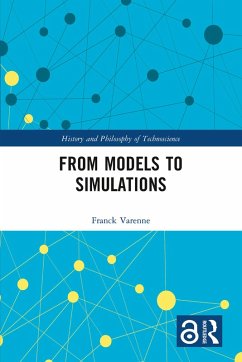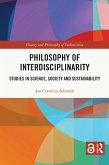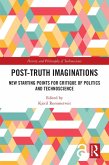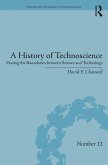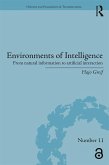

Alle Infos zum eBook verschenken

- Format: ePub
- Merkliste
- Auf die Merkliste
- Bewerten Bewerten
- Teilen
- Produkt teilen
- Produkterinnerung
- Produkterinnerung

Hier können Sie sich einloggen

Bitte loggen Sie sich zunächst in Ihr Kundenkonto ein oder registrieren Sie sich bei bücher.de, um das eBook-Abo tolino select nutzen zu können.
This book analyses the impact computerization has had on contemporary science and explains the origins, technical nature and epistemological consequences of the current decisive interplay between technology and science: an intertwining of formalism, computation, data acquisition, data and visualization and how these factors have led to the spread of simulation models since the 1950s.
Using historical, comparative and interpretative case studies from a range of disciplines, with a particular emphasis on the case of plant studies, the author shows how and why computers, data treatment devices…mehr
- Geräte: eReader
- ohne Kopierschutz
- eBook Hilfe
- Größe: 3.21MB
![Philosophy of Interdisciplinarity (eBook, ePUB) Philosophy of Interdisciplinarity (eBook, ePUB)]() Jan Cornelius SchmidtPhilosophy of Interdisciplinarity (eBook, ePUB)39,95 €
Jan Cornelius SchmidtPhilosophy of Interdisciplinarity (eBook, ePUB)39,95 €![Post-Truth Imaginations (eBook, ePUB) Post-Truth Imaginations (eBook, ePUB)]() Post-Truth Imaginations (eBook, ePUB)0,00 €
Post-Truth Imaginations (eBook, ePUB)0,00 €![Perspectives on Classification in Synthetic Sciences (eBook, ePUB) Perspectives on Classification in Synthetic Sciences (eBook, ePUB)]() Perspectives on Classification in Synthetic Sciences (eBook, ePUB)42,95 €
Perspectives on Classification in Synthetic Sciences (eBook, ePUB)42,95 €![A History of Technoscience (eBook, ePUB) A History of Technoscience (eBook, ePUB)]() David F. ChannellA History of Technoscience (eBook, ePUB)54,95 €
David F. ChannellA History of Technoscience (eBook, ePUB)54,95 €![The Past, Present, and Future of Integrated History and Philosophy of Science (eBook, ePUB) The Past, Present, and Future of Integrated History and Philosophy of Science (eBook, ePUB)]() The Past, Present, and Future of Integrated History and Philosophy of Science (eBook, ePUB)42,95 €
The Past, Present, and Future of Integrated History and Philosophy of Science (eBook, ePUB)42,95 €![The Reform of the International System of Units (SI) (eBook, ePUB) The Reform of the International System of Units (SI) (eBook, ePUB)]() The Reform of the International System of Units (SI) (eBook, ePUB)42,95 €
The Reform of the International System of Units (SI) (eBook, ePUB)42,95 €![Environments of Intelligence (eBook, ePUB) Environments of Intelligence (eBook, ePUB)]() Hajo GreifEnvironments of Intelligence (eBook, ePUB)0,00 €
Hajo GreifEnvironments of Intelligence (eBook, ePUB)0,00 €-
-
-
Using historical, comparative and interpretative case studies from a range of disciplines, with a particular emphasis on the case of plant studies, the author shows how and why computers, data treatment devices and programming languages have occasioned a gradual but irresistible and massive shift from mathematical models to computer simulations.
The Open Access version of this book, available at http://www.taylorfrancis.com, has been made available under a Creative Commons [Attribution-Non Commercial-No Derivatives (CC-BY-NC-ND)] 4.0 license.
Dieser Download kann aus rechtlichen Gründen nur mit Rechnungsadresse in A, B, BG, CY, CZ, D, DK, EW, E, FIN, F, GR, HR, H, IRL, I, LT, L, LR, M, NL, PL, P, R, S, SLO, SK ausgeliefert werden.
- Produktdetails
- Verlag: Taylor & Francis eBooks
- Seitenzahl: 236
- Erscheinungstermin: 3. September 2018
- Englisch
- ISBN-13: 9781351660921
- Artikelnr.: 68874878
- Verlag: Taylor & Francis eBooks
- Seitenzahl: 236
- Erscheinungstermin: 3. September 2018
- Englisch
- ISBN-13: 9781351660921
- Artikelnr.: 68874878
- Herstellerkennzeichnung Die Herstellerinformationen sind derzeit nicht verfügbar.
List of figures
Acknowledgments
List of French abbreviations
Introduction
Chapter 1 - Geometric and botanic simulation
1 The probabilistic simulation of branching biological shapes: Cohen (1966)
2 The epistemic functions of modular programming, simulation and visualization
3 The first geometric and realistic simulation of trees (Honda-Fisher, 1971-1977)
4 The limitations of morphometry and of thermodynamics of trees
5 The first geometric simulation of an actual tree: Terminalia
6 A recap of geometric simulation
Chapter 2: The logical model and algorithmic simulation of algae
1 A botanist won over by logical positivism: the theory of lifecycles by A. Lindenmayer (1963-1965)
2 Unusable set of axioms and used set of axioms
3 From logical theory to automata theory (1966-1967)
4 The developmental model and the rules of rewriting (1968)
5 The dispute with Brian Carey Goodwin regarding natural formalisms
6 Recap: the computer as automata model and deductive machine
Chapter 3: The limitations of biometric models and the transition to simulation in agronomy
1 The institutional and technical context of the IFCC (1966-1971)
2 Transferring a little bit of econometrics to biometrics: a problem of optimization (1974)
3 The first application of plant simulation in agronomics (1974-1975)
4 Fragmented modelling and geometric simulation: de Reffye (1975-1981)
5 Simulation, imitation and the sub-symbolic use of formalisms
Chapter 4: A random and universal architectural simulation
1 Making headway in botany: the notion of architectural model (1966-1978)
2 The search for botanical realism (1978-1979)
3 Criticisms of theoretical models
4 Criticisms of biometric models
5 A mixed reception (1979-1981)
Chapter 5: Convergence between integrative simulation and computer graphics
1 The relaunch of research into architectural simulation (1985-1991)
2 Jaeger's thesis: the prefixed model and synthesis of botanical images (1987)
3 Blaise's thesis: the simulation of buds parallelism (1991)
4 How can an integrative simulation be validated?
Chapter 6: Convergence between universal simulation and forestry (1990-1998)
1 An epistemological dispute between modellers: INRA and CIRAD
2 Conceptual and institutional convergence: the CIRAD/INRA partner laboratory (1995)
3 The empirical value of simulation
4 Supra-simulations
Chapter 7: The remathematization of simulations (from 1998 onwards)
1 The first mixed structure-function model: water efficiency (1997-1999)
2 The parallel evolution of algorithmic simulation: 1984-1994
3 Simulating the individual plant in order to observe crop functioning (1997-2000)
4 The association between AMAP and INRIA: sub-structures and factorization (1998-2006)
5 Recap: pluriformalized simulation and convergence between disciplines
Chapter 8: Twenty-one functions of models and three types of simulations - Classifications and applications
1 General function, main functions and specific functions of models
2 General characterization and classification of computer simulations
3 System simulation, model simulation, system-simulation model and model-simulation model
4 Applications to different plant models and plant simulations
Conclusion
Glossary
Selected Bibliography
Index of names
Index of subjects
List of figures
Acknowledgments
List of French abbreviations
Introduction
Chapter 1 - Geometric and botanic simulation
1 The probabilistic simulation of branching biological shapes: Cohen (1966)
2 The epistemic functions of modular programming, simulation and visualization
3 The first geometric and realistic simulation of trees (Honda-Fisher, 1971-1977)
4 The limitations of morphometry and of thermodynamics of trees
5 The first geometric simulation of an actual tree: Terminalia
6 A recap of geometric simulation
Chapter 2: The logical model and algorithmic simulation of algae
1 A botanist won over by logical positivism: the theory of lifecycles by A. Lindenmayer (1963-1965)
2 Unusable set of axioms and used set of axioms
3 From logical theory to automata theory (1966-1967)
4 The developmental model and the rules of rewriting (1968)
5 The dispute with Brian Carey Goodwin regarding natural formalisms
6 Recap: the computer as automata model and deductive machine
Chapter 3: The limitations of biometric models and the transition to simulation in agronomy
1 The institutional and technical context of the IFCC (1966-1971)
2 Transferring a little bit of econometrics to biometrics: a problem of optimization (1974)
3 The first application of plant simulation in agronomics (1974-1975)
4 Fragmented modelling and geometric simulation: de Reffye (1975-1981)
5 Simulation, imitation and the sub-symbolic use of formalisms
Chapter 4: A random and universal architectural simulation
1 Making headway in botany: the notion of architectural model (1966-1978)
2 The search for botanical realism (1978-1979)
3 Criticisms of theoretical models
4 Criticisms of biometric models
5 A mixed reception (1979-1981)
Chapter 5: Convergence between integrative simulation and computer graphics
1 The relaunch of research into architectural simulation (1985-1991)
2 Jaeger's thesis: the prefixed model and synthesis of botanical images (1987)
3 Blaise's thesis: the simulation of buds parallelism (1991)
4 How can an integrative simulation be validated?
Chapter 6: Convergence between universal simulation and forestry (1990-1998)
1 An epistemological dispute between modellers: INRA and CIRAD
2 Conceptual and institutional convergence: the CIRAD/INRA partner laboratory (1995)
3 The empirical value of simulation
4 Supra-simulations
Chapter 7: The remathematization of simulations (from 1998 onwards)
1 The first mixed structure-function model: water efficiency (1997-1999)
2 The parallel evolution of algorithmic simulation: 1984-1994
3 Simulating the individual plant in order to observe crop functioning (1997-2000)
4 The association between AMAP and INRIA: sub-structures and factorization (1998-2006)
5 Recap: pluriformalized simulation and convergence between disciplines
Chapter 8: Twenty-one functions of models and three types of simulations - Classifications and applications
1 General function, main functions and specific functions of models
2 General characterization and classification of computer simulations
3 System simulation, model simulation, system-simulation model and model-simulation model
4 Applications to different plant models and plant simulations
Conclusion
Glossary
Selected Bibliography
Index of names
Index of subjects
